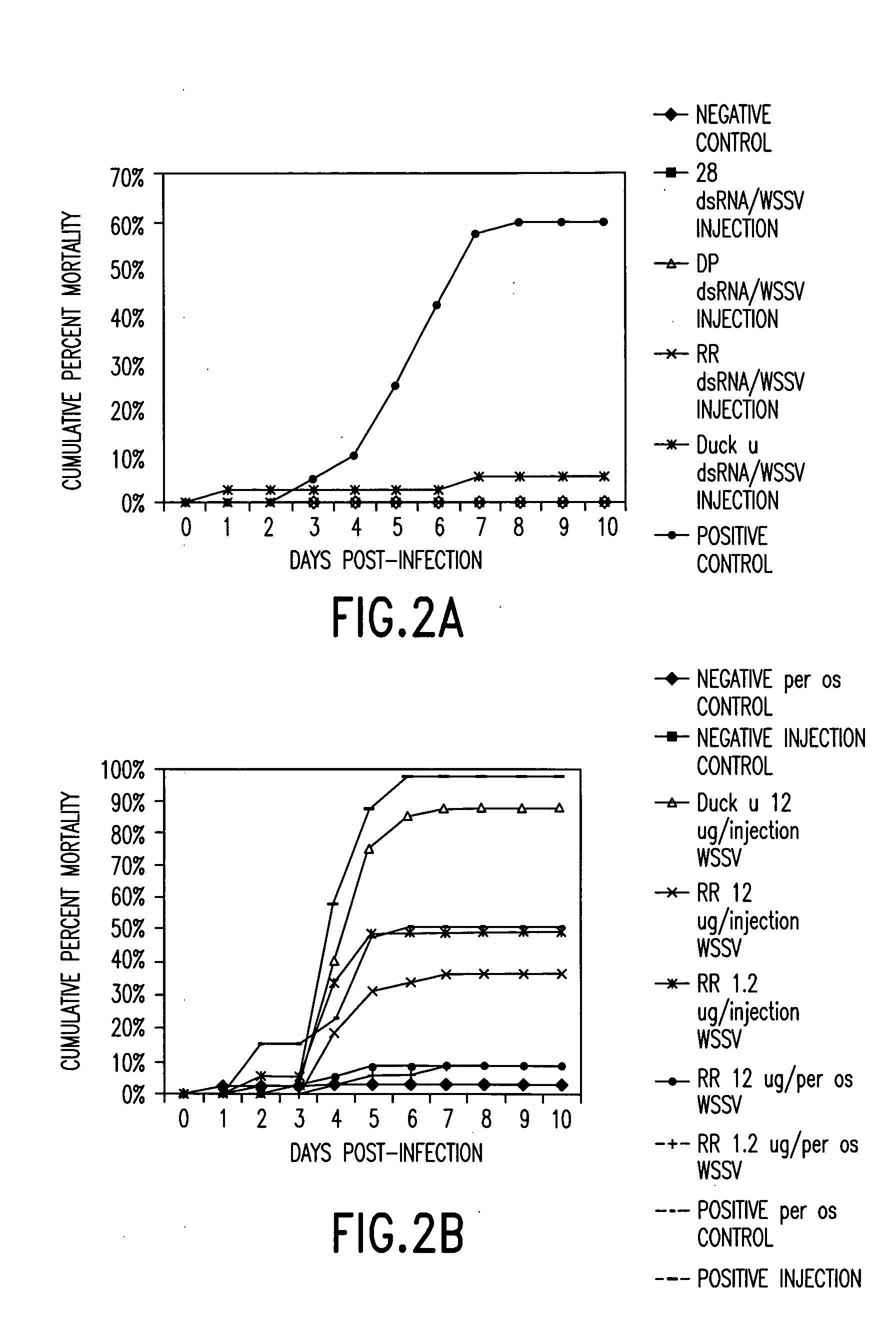dsRNA induced specific and non-specific immunity in crustaceans and other invertebrates and biodelivery vehicles for use therein
a biodelivery vehicle and specific and non-specific immunity technology, which is applied in the direction of immunological disorders, antibody medical ingredients, antibacterial agents, etc., can solve the problems of limited use of antisense interference for gene therapy or other whole-organism applications, inefficient uptake of unmodified single-stranded materials, and inability to fully understand innate invertebrate immunity. to achieve the effect of facilitating a greater understanding of innate invertebrate immunity
- Summary
- Abstract
- Description
- Claims
- Application Information
AI Technical Summary
Benefits of technology
Problems solved by technology
Method used
Image
Examples
example 1
[0184] Use of dsRNA-mediated Genetic Interference to Block Viral Infection in the Marine Shrimp Litopenaeus vannamei.
[0185] In this example, it is shown that treatment of shrimp with dsRNA representing genes encoded in the WSSV genome effectively protected them against WSSV infection. These results provide the first evidence of an RNAi pathway in shrimp, and open the possibility of developing antiviral strategies using dsRNA-related therapeutics in aquaculture.
[0186] Shrimp and WSSV: The bioassay system, experimental animals, and WSSV inoculum used in these studies have been described elsewhere. Briefly, Litopenaeus vannamei (1-2 g) were stocked individually in 260 ml tissue-culture flasks and acclimated for a 3 day period, with 100% daily water exchange (artificial seawater, Marine Environment.RTM., and fed a small piece (about half a pellet) of commercial feed every day. Animals were then treated by intramuscular injection of dsRNA and infected with WSSV either by injection or per...
example 2
[0193] Further Characterization of Anti-WSSV Protection by dsRNA Encoding Four WSSV Genes.
[0194] Task 1 aims to provide an initial comparison of selected WSSV genes. Based upon the quality of the EST clones and the expected role of the gene in viral replication, differences in efficacy of dsRNA in generating a protective effect may be found. These experiments will establish methods for dsRNA production and allow evaluation of some of the most important clones from our WSSV EST collection.
[0195] Clone 4 WSSV Genes (vp26, vp19, Thymidylate Kinase, DNA Polymerase) and Produce Long dsRNA.
[0196] Methods
[0197] Six WSSV genes rather than 4 were used. These were vp19 (an envelope protein, GenBank accession#AA069661); vp26 (a protein of the nucleocapsid, GenBank accession#AA069663); vp28 (an envelope protein, GenBank accession#AAL33423); VF (a viral protein of unknown function, GenBank accession#AAL33255), DNA polymerase (an enzyme involved in the replication of the viral genome, GenBank acc...
example 3
[0203] dsRNA Preparations Alone and In Combination for Protection Against WSSV Infection.
[0204] Methods
[0205] Five of the genes of the prior example were tested for their ability to protect shrimp from infection with WSSV. The experiment that was performed was as follows: 1) the challenge dose of virus was given by feeding WSSV-infected shrimp tissue (5% of body weight daily) for 2 days. The control (uninfected) animals were fed the same amount of uninfected shrimp tissue (5% daily) for 2 days. This per os challenge with a lethal dose of virus was chosen over injection of an LD.sub.90 dose of WSSV because it is more representative of the mode of viral challenge in a real world environment and because it provides much more stringent testing of the shrimp's resistance. The protective effect of the WSSV genes was not compared to that of non-specific-dsRNA (e.g. duck IgY). Comparing the results obtained in this study using non-specific stimulation, with our initial results using virus-s...
PUM
| Property | Measurement | Unit |
|---|---|---|
| Brittleness | aaaaa | aaaaa |
| Immunogenicity | aaaaa | aaaaa |
| Toxicity | aaaaa | aaaaa |
Abstract
Description
Claims
Application Information
 Login to View More
Login to View More - R&D
- Intellectual Property
- Life Sciences
- Materials
- Tech Scout
- Unparalleled Data Quality
- Higher Quality Content
- 60% Fewer Hallucinations
Browse by: Latest US Patents, China's latest patents, Technical Efficacy Thesaurus, Application Domain, Technology Topic, Popular Technical Reports.
© 2025 PatSnap. All rights reserved.Legal|Privacy policy|Modern Slavery Act Transparency Statement|Sitemap|About US| Contact US: help@patsnap.com



